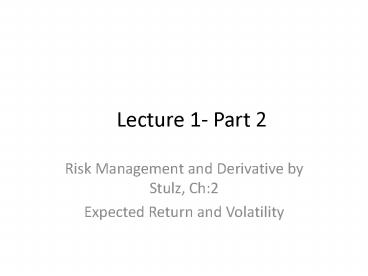Lecture 1- Part 2 PowerPoint PPT Presentation
1 / 18
Title: Lecture 1- Part 2
1
Lecture 1- Part 2
- Risk Management and Derivative by Stulz, Ch2
- Expected Return and Volatility
2
Knowing risk and return of securities and
portfolios
- A key measure of investors success is the rate
at which their funds have grown - Holding-period return (HPR) of shares is composed
of capital gain and dividend - HPR (P1-Po Cash Dividend)/Po
- This definition assumes end of period returns and
ignores re-investment of income
3
Return Distributions
- If the return on a stock is fixed, there will be
100 probability (Certaininty)that the return
will be realized, like in bonds and T-bills - In stocks, return is not fixed so the probability
of all likely outcomes should be assessed - Probability is the chance that the specified
outcome will occur
4
- Probability distribution is the specification of
likely outcomes and the probability associated
with each outcome - Suppose we expect that PPL can give either 10,
20 or -5 return. So we have three possible
outcomes, if we associate chances of occurrence
with each return, then it becomes probability
distribution
5
Expected Return
- Expected return is the single most likely outcome
from a PD - It is calculated by taking a weighted average of
all possible return outcomes - E(R) SRiPi
6
An Example
Oil Prices Return Probability RiPi
Flat 0.10 0.30 0.03
Rise 0.2 0.50 .1
Fall 0 0.20 0
Sum .13
7
Variance of Returns (Risk)
- Variance of a random variable is a statistical
tools that measures how the realization of the
random variable are distribute around their
expected values - In other words it measures risk
- Variance SRi-E(R)2 Pi
8
Variance of Returns (Risk)
- Standard Deviation taking square root of
.00600, we get value of 0.077 or 7.7
Return Probability RiPi Ri-E(R) SRi-E(R)2 SRi-E(R)2 Pi
0.10 0.30 0.03 -.03 .0009 .00027
0.2 0.50 .1 .07 .0049 .00245
0 0.20 0 -.13 .0169 .00338
Sum .13 .00600
9
Cumulative Distribution Function
- The cumulative distribution function of a random
variable y specifies, for any number y, the
probability that the realization of the random
variable will be no greater than y - For POL, a reasonable estimate of the stock
return volatility is 9.2 with expected return of
13, the following table show cumulative
distributions functions for different levels of
returns
10
Cumulative Distribution Function
11
How to Calculate CDF
- CDF can easily be calculated with MS Excel
- Put the equal sign in a cell
- Open parenthesis and give x value (x means the
level of return for which you want cumulative
probability) - Then give the mean return value,
- Then the standard deviation value
- And finally write TRUE and close parenthesis
12
Interpretation
- Taking values from the table in the previous
slide, CDF is .59 with the 20 return level - It means that there is 59 probability that
return on POL will be less than 20 - An investor has Rs.100,000 investment in POL and
he wants that he does not lose more than Rs.30000
of his investment, what is the probability of
this occurrence
13
Return of a Portfolio
- To calculate an average rate on a combination of
stocks, we simply take the weighted average
return of all stocks - E(Rp) Swi E(Ri)
- Wi Weight of the security in the poftfolio
- E(Rp) The expected return on the portfolio
14
Calculating portfolio return
- Calculating weights PPL 20000/60000 .33
- FFC 30000/6000 .5 Lucky 10000/60000
.16
Stock Value Return Weight Swi E(Ri
PPL 20000 15 .33 4.95
FFC 30000 12 .5 6
Lucky 10000 10 .16 1.6
Sum 12.55
15
Calculating Portfolio Risk
- Risk of the porftolio is not the weighted average
risk of the individual securities - Rather it is determined by three factors
- 1.the SD of each security
- 2. the covariance between the securities
- The weights of securities in the portfolio
16
Diversification
- By combining negatively correlated stocks, we can
remove the individual risks of the stocks - Example Pol face the risk of falling oil prices
- PIA face the risk of rising oil prices
- By combining these two stocks, reduction in
return in one stock due to change in oil price is
compensated by increase in return of the other
stock - However, all of market risk cannot be eliminated
through diversification
17
Efficient Frontier
- Investors should select portfolios on the basis
of expected return and risk - A portfolio is efficient if
- 1 it has the smallest level of risk for a given
return or - 2. largest return for a given level of risk
- To select efficient portfolios, investors should
find out all portfolios opportunities set - i.e find out risk and return set for all
portfolios
18
Efficient Frontier
- Example given in the Excel File
- Steps
- 1. Calculate securities return
- 2. calculate portfolio returns
- 3. Find portfolio risk
- 4. Make different portfolios by changing weights
of the securities - 5. Find risk and return of each portfolio
developed in step 4 - 6. Plot the risk and return of these portfolios
- 7. Find the minimum variance portfolio
- 8. Portfolios above the minimum variance
portfolios are efficient

